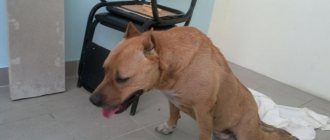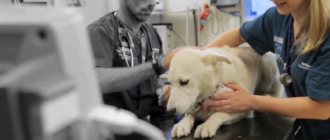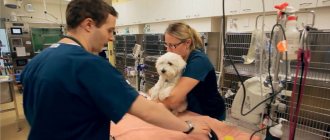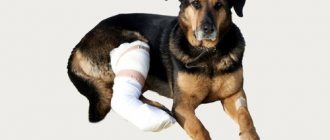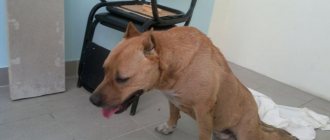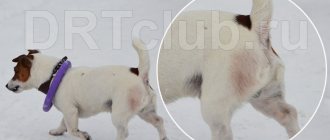They get entangled
A Pug's hind legs can become weak for several reasons.
Discopathy
This is a displacement of the vertebral discs with subsequent formation of a hernia. It often occurs in representatives of this breed due to the specific structure of the body. The hernia compresses the spinal cord, which, in turn, can lead to disability or even death of the dog.
Note! Discopathy is more likely to occur in dogs that are overweight or have a hereditary predisposition.
A pug suffering from discopathy often freezes or winces from back pain during walks and has difficulty bending over to the bowl.
Distributing the weight across all four paws becomes impossible, so the dog tries to lean on his front paws, which looks very strange from the outside: he begins to seem to “shuffle” with his hind paws. The pug can no longer jump on furniture or go up or down stairs on his own.
Myositis
The disease can occur in dogs of any age, size and breed. This is inflammation of the muscles as a result of injury, excessive physical activity or hypothermia. The dog's gait becomes springy, which is especially noticeable on the hind legs.
Dysplasia
Pugs have a genetic predisposition to developing hip dysplasia, even though the condition is most common in large breed dogs.
In addition, home maintenance has an effect - if the dog moves most of the time on parquet or tiles (i.e., on slippery and smooth surfaces) - the risk of getting a dislocated hip joint doubles.
With dysplasia, the pug refuses active games, preferring passive observation from the side from a lying or sitting position. Sometimes the dog has a hard time getting up after waking up or refuses to go up the stairs.
The most common diseases
Typical diseases common among pugs are:
- Gastrointestinal dysfunction in a pug. Diarrhea in a pug can occur either as a result of a serious illness or poisoning from low-quality products. If a dog is vomiting and has diarrhea, then it must be constantly watered; the pet may refuse to drink on its own, in which case it must be given water from a syringe. Only a veterinarian will be able to accurately determine the cause of unpleasant symptoms, prescribe treatment and select a diet for the dog.
- Pugs have a unique and unusual skull structure, which is why they differ from other dog breeds in that their eyes fall out. With this pathology, pugs’ visual organs bulge greatly and turn red. In order to correct the situation, human intervention is necessary, since the animal will not be able to cope with the problem that has arisen. However, it is important to remember that under no circumstances should you try to correct the situation yourself; this should only be done by a specialist. If such a situation arises, it is necessary to bandage the eyes with gauze soaked in saline or salted water, and in this condition, take the dog to the doctor.
- There are also pathologies that are quite common among pug dogs - inflammation of the cornea and chronic inflammation of the organs of vision. Keratitis is characterized by redness and then clouding of the cornea. At a later stage, the animal’s eyes begin to water and fester; over time, the dog loses the ability to open the diseased eye. If the disease is not treated and everything is left to chance, then this threatens with the most severe consequences, that is, removal of the eye.
- Pigmentary keratitis or chronic inflammation of the cornea is characterized by the accumulation of melanin pigment in the epithelium of the visual organs. The cause of the development of this pathology is chronic irritation of the cornea of the eye. Visually, the pathology manifests itself in pigment spots on the eyes. With pigmentary keratitis, the dog may partially lose vision or become completely blind.
- Ears are another problem for Pugs. The most common ear pathology among pugs is otitis media, in which the inside of the ear becomes inflamed and red. Often the disease can be confused with an allergy, since the signs of the diseases are the same. But with otitis media, the following symptoms also appear: increased secretion of sulfur, accumulation of fluid in the ears, odor from the ears. Peeling and itching may indicate allergies.
Expert opinion
Tolkachev Andrey Mikhailovich
veterinarian
The most common diseases of pugs, such as diseases of the ears, eyes, malfunctions of the gastrointestinal tract, as well as injury to pets, occur in most cases due to the fault of the owners. Many pug owners, when purchasing an animal, do not know how to properly care for it in order to prevent the development of pathologies that arise in the physiological anatomy of the pet. Very often, the hygiene of the animal is carried out incorrectly, as a result of which diseases of the eyes, ears and skin of pugs are so common, as well as situations when the pet often pees. Therefore, before purchasing a pug, it is recommended to carefully study all the issues related to its care; in addition, timely visits to the veterinarian and vaccinations will help the pet feel great and delight its owners.
They refuse
Complete failure of the limbs is possible against the background of aseptic necrosis of the femoral head. The disease impairs blood circulation in the femur, which in turn affects the mobility of the hind legs.
The situation can only be corrected by surgery. If you let the disease take its course, the necrotic process affects the muscles and they dry out.
Video: Paralysis of the hind legs in dogs
If your pet cannot walk due to paralysis of its hind legs, all is not lost. There is always hope!
Was this article helpful?
Thank you for your opinion!
The article was useful. Please share the information with your friends.
Yes (100.00%)
No
X
Please write what is wrong and leave recommendations on the article
Cancel reply
Rate the benefit of the article: Rate the author ( 8 votes, average: 4.38 out of 5)
Discuss the article:
If he constantly licks
The urge to lick paws in a pug can be due to several reasons.
Allergies – rashes, itching, swelling and irritation on the pads of the paws cause a lot of discomfort for the dog. Considering the propensity of pugs to allergies, there can be many reasons for the disease - from flowering to eating inappropriate foods.
Reference! The exact root cause of allergies can only be determined through laboratory tests.
Fungal infection - the introduction of fungus under the skin is as unpleasant for a dog as an allergy. Licking herself, she tries to relieve the unbearable itching and burning. Treatment of a fungal infection is medicinal and usually takes no more than two weeks.
Inflammation of an open wound/splinter/cut – most often pugs injure the pads of their toes or the delicate skin between them. Moreover, even the smallest splinter or scratch can cause severe inflammation and pain. Carefully examine your pet's paws and treat the areas of inflammation with an antiseptic.
A bite of an insect. Fleas, mosquitoes, wasps or ticks cause a lot of trouble for man's four-legged friends. Ticks are especially dangerous. If an insect is found on the animal’s body, it must be completely eliminated, the bite site should be treated with an antiseptic, and the pet should be shown to a doctor.
Long claws. The problem of excessively long claws is quite common in this breed. The more time a dog spends at home, the worse its claws get on the asphalt and ground. As a result, the claws can become so long that the dog simply finds it uncomfortable to walk.
Chemical burn. A pug can get a chemical burn by walking on a floor washed with bleach, snow sprinkled with reagents, or grass treated for parasites.
Stress. A dog may lick its paws due to a nervous disorder caused by being alone for a long time, insufficient attention from the owner, or short walks.
How to tell if your pug is sick
There are a number of characteristic symptoms in the behavior of pugs that you should pay attention to. The first of them is that your active pet began to sleep too much, became lethargic and sad. Vomiting and fever are a very alarming signal that indicates a serious illness. If a pug scratches its eyes, this is also a reason to urgently contact a veterinarian. The animal may become irritable and angry; in general, any changes in the character of your pet deserve special attention. You should also pay attention to discharge from the nose and eyes, as well as the animal’s feces.
Return to content
Cold houses, warm
Normally, a pug's paw pads should be slightly cooler than the rest of his body. In addition, the rougher the skin, the longer it retains body heat. Accordingly, cool paw pads for pugs who prefer relaxing on the couch to playing outside are a normal situation.
Reference! Pugs do not tolerate severe frosts well - if you decide to take your dog for a walk in the cold, make sure that its paws are protected with special shoes.
If the paws are noticeably colder than the body and this phenomenon is accompanied by strange behavior of the pet, immediately show it to a specialist. There may be several reasons for this:
- Poisoning – a decrease in body temperature is accompanied by attacks of vomiting and diarrhea.
- Anemia – a decrease in the level of red blood cells leads to oxygen starvation of cells. The body supplies blood only to vital organs, leaving the paw pads and ears abnormally cold.
- Paralysis – can develop as a result of injury or pinched nerves. With paralysis, the limbs completely or partially lose sensitivity, and the hind legs seem noticeably colder than the front ones.
- Vascular atherosclerosis – occurs in pugs over 6 years of age. The disease is caused by loss of elasticity of the vascular walls and deterioration of blood supply to the extremities.
- Vegetative-vascular dystonia - the heart can work to the limit to provide vital functions, but there will not be enough blood to warm the extremities.
Treatment
Of course, in order to help your pet, you need to know exactly the cause of the disease, and for this you need to contact a veterinary clinic. It is advisable to get an appointment immediately with a doctor specializing in neurology. Even simple lameness or difficulty getting up can be a reason to visit the veterinarian. Do not think that this is a short-term phenomenon that will go away on its own. It’s good if so, but this could also be the first sign of very serious illnesses.
If your pet is injured, jumps unsuccessfully, or pulls a muscle, do not delay going to the veterinarian. Only competent treatment can save the dog from subsequent negative manifestations. It is strictly forbidden to use painkillers without a doctor's recommendation. Moreover, the pain will limit the animal’s movement, which means the risk of even greater injury will be eliminated.
Remember that only a timely visit to a specialist and a competent approach to treatment will help to fully get the dog back on its feet. Otherwise, help may be ineffective and then your pet will only have one sentence - a stroller. Depending on the diagnosis and cause of the disease, the veterinarian may prescribe treatment with medications, massage, certain physical activities, diet, etc.
First aid for a pet
Regardless of the nature of the injury, its extent or signs, it is important to get your pet to the clinic as soon as possible. At the same time, you cannot force him to walk if his motor function is still possible. Pick up the dog or place it in the car and take it to the veterinarian. The specialist must establish the integrity of paw sensitivity, check for pain, the presence of injuries and pathologies. The doctor may also take blood and urine tests for additional information.
If your dog's back legs are giving out, you should restrain him on a strong, hard surface. Any medications, including painkillers, cannot be given. It is important to carefully deliver the dog to the veterinary clinic as quickly as possible without unnecessary shaking.



